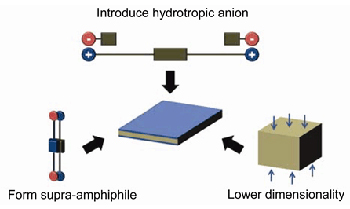

Controlled Fabrication of Two-Dimensional Organic Assemblies
Received date: 2016-04-21
Online published: 2016-05-13
Supported by
Project supported by the Foundation for Innovative Research Groups of the National Natural Science Foundation of China (No. 21421064) and the National Basic Research Program of China (No. 2013CB834502).
Two-dimensional (2D) organic assemblies possess many intriguing properties such as planar structure, extended surface, flexibility and tailorability. The fabrication of 2D organic structures in a controlled manner is crucial to realize their potential functions and applications. In recent years, we have developed three methods to fabricate 2D organic assemblies through the rational design of building blocks. Firstly, hydrotropic anions will induce cationic bolaamphiphiles to form 2D assemblies, because such anions can insert their hydrophobic parts into the assemblies and weaken the electrostatic repulsion between adjacent headgroups. Secondly, the topology of supra-amphiphiles can be easily tuned because of the dynamic nature of non-covalent bonds, thus providing a facile approach for the fabrication of 2D assemblies. Thirdly, through molecular modification or introduction of new non-covalent bonds, we can lower the dimensionality of three-dimensional (3D) networks to form 2D assemblies. It is highly anticipated that these methods can be further applied for the preparation of functional 2D nano/micro materials for optoelectronics.

Xu Jun , Wang Zhiqiang , Zhang Xi . Controlled Fabrication of Two-Dimensional Organic Assemblies[J]. Acta Chimica Sinica, 2016 , 74(6) : 467 -471 . DOI: 10.6023/A16040200
[1] Kimizuka, N.; Kawasaki, T.; Kunitake, T. J. Am. Chem. Soc. 1993, 115, 4387.
[2] Davis, R.; Berger, R.; Zentel, R. Adv. Mater. 2007, 19, 3878.
[3] Chen, Y.; Zhu, B.; Zhang, F.; Han, Y.; Bo, Z. Angew. Chem., Int. Ed. 2008, 47, 6015.
[4] Lee, E.; Kim, J. K.; Lee, M. Angew. Chem., Int. Ed. 2009, 48, 3657.
[5] Nam, K. T.; Shelby, S. A.; Choi, P. H.; Marciel, A. B.; Chen, R.; Tan, L.; Chu, T. K.; Mesch, R. A.; Lee, B. C.; Connolly, M. D.; Kisielowski, C.; Zuckermann, R. N. Nat. Mater. 2010, 9, 454.
[6] An, Q.; Chen, Q.; Zhu, W.; Li, Y.; Tao, C. A.; Yang, H.; Li, Z.; Wan, L.; Tian, H.; Li, G. Chem. Commun. 2010, 46, 725.
[7] Zhao, Y. S.; Fu, H.; Peng, A.; Ma, Y.; Xiao, D.; Yao, J. Adv. Mater. 2008, 20, 2859.
[8] Li, R.; Hu, W.; Liu, Y.; Zhu, D. Acc. Chem. Res. 2010, 43, 529.
[9] Li, S.; Huang, X.; Zhang, H. Acta Chim. Sinica 2015, 73, 913.(李绍周, 黄晓, 张华, 化学学报, 2015, 73, 913.)
[10] Israelachvili, J. N.; Marcelja, S.; Horn, R. G. Q. Rev. Biophys. 1980, 13, 121.
[11] Leontidis, E. Curr. Opin. Colloid. In. 2002, 7, 81.
[12] Song, B.; Wang, Z.; Chen, S.; Zhang, X.; Fu, Y.; Smet, M.; Dehaen, W. Angew. Chem., Int. Ed. 2005, 44, 4731.
[13] Yin, S.; Song, B.; Liu, G.; Wang, Z.; Zhang, X. Langmuir 2007, 23, 5936.
[14] Song, B.; Liu, G.; Xu, R.; Yin, S.; Wang, Z.; Zhang, X. Langmuir 2008, 24, 3734.
[15] Wu, G.; Verwilst, P.; Xu, J.; Xu, H.; Wang, R.; Smet, M.; Dehaen, W.; Faul, C. F. J.; Wang, Z.; Zhang, X. Langmuir 2012, 28, 5023.
[16] Wu, G.; Thomas, J.; Smet, M.; Wang, Z.; Zhang, X. Chem. Sci. 2014, 5, 3267.
[17] Wu, G.; Verwilst, P.; Liu, K.; Smet, M.; Faul, C. F. J.; Zhang, X. Chem. Sci. 2013, 4, 4486.
[18] Zhang, X.; Wang, C. Chem. Soc. Rev. 2011, 40, 94.
[19] Wang, C.; Wang, Z.; Zhang, X. Acc. Chem. Res. 2012, 45, 608.
[20] Zhang, X.; Wang, C.; Wang, Z. Sci. China-Chem. 2011, 41, 216.(张希, 王朝, 王治强, 中国科学: 化学, 2011, 41, 216.)
[21] Kimizuka, N.; Kawasaki, T.; Hirata, K.; Kunitake, T. J. Am. Chem. Soc. 1998, 120, 4094.
[22] Oda, R.; Huc, I.; Schmutz, M.; Candau, S. J.; MacKintosh, F. C. Nature 1999, 399, 566.
[23] Wang, C.; Yin, S.; Chen, S.; Xu, H.; Wang, Z.; Zhang, X. Angew. Chem., Int. Ed. 2008, 47, 9049.
[24] Zhang, X.; Chen, Z.; Wurthner, F. J. Am. Chem. Soc. 2007, 129, 4886.
[25] Liu, K.; Wang, C.; Li, Z.; Zhang, X. Angew. Chem., Int. Ed. 2011, 50, 4952.
[26] Li, F.; Song, Q.; Yang, L.; Wu, G.; Zhang, X. Chem. Commun. 2013, 49, 1808.
[27] Athikomrattanakul, U.; Promptmas, C.; Katterle, M.; Schilde, U. Acta Crystallogr., Sect. E: Struct. Rep. Online 2007, 63, o2154.
[28] Xu, J.; Wu, G.; Wang, Z.; Zhang, X. Chem. Sci. 2012, 3, 3227.
[29] Miyazaki, Y.; Kanbara, T.; Yamamoto, T. Tetrahedron Lett. 2002, 43, 7945.
[30] Yi, Y.; Fa, S.; Cao, W.; Zeng, L.; Wang, M.; Xu, H.; Zhang, X. Chem. Commun. 2012, 48, 7495.
/
| 〈 |
|
〉 |